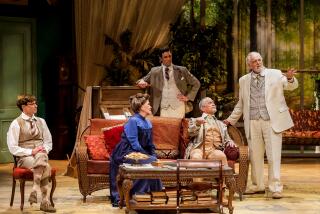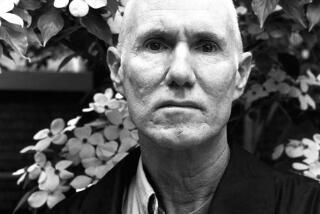The Search for Shaw : BERNARD SHAW VOLUME I 1856-1898: The Search for Love <i> by Michael Holroyd (Random House: $24.95; 486 pp.) </i>
- Share via
It is well for the tranquillity of Michael Holroyd and Random House that George Bernard Shaw did not believe in an afterlife. Otherwise, they would be riding out a spectral blast--withering and, no doubt, restorative--over the title of the first volume of his biography.
This emotional evader; this intellectual seducer who almost invariably pulled back when a woman mistook his passion to dazzle and persuade for something more personal; this red-bearded Puck who, when he got married, inserted a newspaper notice calling the whole thing an unforeseen mix-up owing to a rain shower that obliged him and his companion to take shelter in the Registry office; this vehement anti-sentimentalist who despaired because actors insisted on cuddling his astringencies--all this under the subtitle of “The Search for Love”?
Holroyd, whose “Lytton Strachey” inaugurated a generation of literary Bloomsburying, is one of the most individual and talented of English biographers. He did not make a mistake. He made a challenge. After 15 years’ work, he has not simply written Shaw’s life. He has besieged it.
This volume--there are to be two more--takes Shaw from his Dublin infancy to age 42. He had triumphed as a music and theater critic, as a pamphleteer and controversialist, as a stump-speaker for Socialism.
He had also written five failed novels and seven plays that misfired in one fashion or other (among them, “Candida,” “Mrs. Warren’s Profession” and “Man of Destiny”). It was only now that he faced his first big success with “The Devil’s Disciple”; and--after all manner of more (rhetorical) or less (fleshly) romantic entanglements--marriage.
Holroyd could have settled for a biographical jaunt. For many years, and for many biographies, Shaw was his own tour guide. He overwhelmed writers with helpfulness, with wittily searching insights into himself and those he knew. The result was supremely agreeable; it was Shaw’s life as a Shavian scenario.
Entrusted by Shaw’s literary heirs with assembling a new and massive biography, Holroyd has taken a different course. He is not Shaw’s instrument; he is Shaw’s Shaw.
Some years ago, he expressed the hope that readers would find him irritating, and he may well have succeeded. He wrestles his subject out of the subject’s view of reality and into his own; just as Shaw used to do. He can be as paradoxical, as opinionated and as elusive; and frequently, if not quite as witty, very witty indeed.
Shaw’s typewriter was “a marvelously efficient machine for turning all the difficulties and despairs of life into argument,” Holroyd writes. It is Holroyd’s typewriter too.
Shaw’s was “a style that is always in top gear: emphatic, industrious, omniscient, studded with surprises and better trained for shorter distances than the long discussion that was to become a feature of his work.” It is Holroyd’s style too; it furnishes our delight in his individual perceptions and a certain misgiving about his long distances.
Holroyd’s detail is immense and for the most part well-chosen. Some of it is certainly printed for the first time; though how much, only a Shavian scholar would know; and even he or she would be considerably irritated. Holroyd provides no notes; he tells us cavalierly that these will be furnished in a separate volume when the Life is completed.
General readers, he tells us, do not require notes. This general reader could have used a few. For example, we get Jenny Patterson’s side of what was Shaw’s first full-fleshed love affair. It gives an emotional context that is missing from Shaw’s own accounts. She was his mother’s friend, and possessive. Shaw emerges, ruefully, as a young bear who has embraced a honeycomb full of old bees. But is this a new glimpse?
Holroyd tells us all about everything: Shaw’s clothes, his diet, his living arrangements, his mother and father, his complex dealings with all manner of different women, his bicycling, his political stumping, how local government functioned in the London borough of St. Pancras where Shaw served six years as a councilman. Along with this rich background, there is a searching and often brilliant account of his work as a critic, a novelist and a budding playwright.
The detail, good as most of it is, causes problems. Holroyd tends to treat the 42 years, not as a flow, but as a collection of successive topics taken one by one. This allows the author to tackle each head-on and to focus a powerful attention; on the other hand, we can lose the man--or more exactly, the life--in the particulars.
Holroyd is never dry, ponderous or academic. On the contrary, he is impassioned and fervently intuitive. Each fact sets him ablaze. The choppiness and the passion sometimes give the effect of the montage in an old expressionist film. Here is a passage, admittedly more perfervid than most: At a conference in Switzerland, Shaw “would dive out at lunch to make the snow water of the lake sizzle with his intensity.”
Holroyd’s own intensity is at its greatest when he wrestles with the central perplexities that Shaw aroused from the start--the mysteries of the Shavian style.
In his plays, his polemics and his correspondence, he would stitch wit and paradox through the souls of his characters, the solemnity of his arguments, and the feelings of those he wrote to. This especially bothered his contemporaries (and not a few of his woman friends). Is he serious? they wanted to know.
Holroyd understands what the man was about. “We often get from Shaw fewer expressions of truth than statements designed to hoodwink us into the truth,” he writes, nicely encapsulating Shaw’s own argument. And he goes beyond, to question Shaw’s use of mockery and self-mockery of the world’s and his own seriousness:
“The effect, he thought, was homeopathic; and self-disparagement, even of a paradoxical kind, increased people’s respect. In fact, it seems to have increased their entertainment but spread a film of incredulity over many of his hearers.”
Today, there are many who object to Shaw’s plays because they find them emotionally starved. The wit, they feel, is at the expense of dramatic profundity. The characters, so the complaint goes, are stick figures brandishing clever placards.
Holroyd is not nearly so simplistic. And yet, his massive and powerful book rides on two curiously contending passions.
One is to know Shaw, to get as close to him as possible, to use every obtainable detail in an effort to see him, and let us see him. The other is his refusal to conceive that Shaw’s essence consisted precisely of the wit, the gaiety, the paradox and the unstoppable energy with which he battled the world’s darkness.
Holroyd--a modern, a biographer whose gift with his Bloomsburyites was his use of psychological and psychoanalytic intuitions--tries the same thing on Shaw. He goes so far as to invent a “Sonny” whom he employs well into his subjects’ 40s to trace the effect of childhood pain on the artist’s energies.
Evasion is the word he uses: “Overcoming rather than confronting truth.” One senses the author’s frustration with this unstoppably verbal man who refuses to sit down and have an intimate talk about himself. Holroyd wants to know what makes Shaw tick. Shaw will not sit down; he refuses to stop ticking.
Shaw, the author insists, reorganized life’s pain so it could be settled by argument. He was dedicated “to overcoming rather than confronting truth.”
It is a curious complaint. A bird rearranges gravity so it can be settled by flight. Living is more about overcoming death than confronting it. Art has more to do with achieving flight than anatomizing gravity.
Holroyd on Shaw can remind us of Shaw on Shakespeare; each is exhilarated by his gorgeous subject; each goads at the subject for not being more like himself
More to Read
Sign up for our Book Club newsletter
Get the latest news, events and more from the Los Angeles Times Book Club, and help us get L.A. reading and talking.
You may occasionally receive promotional content from the Los Angeles Times.










